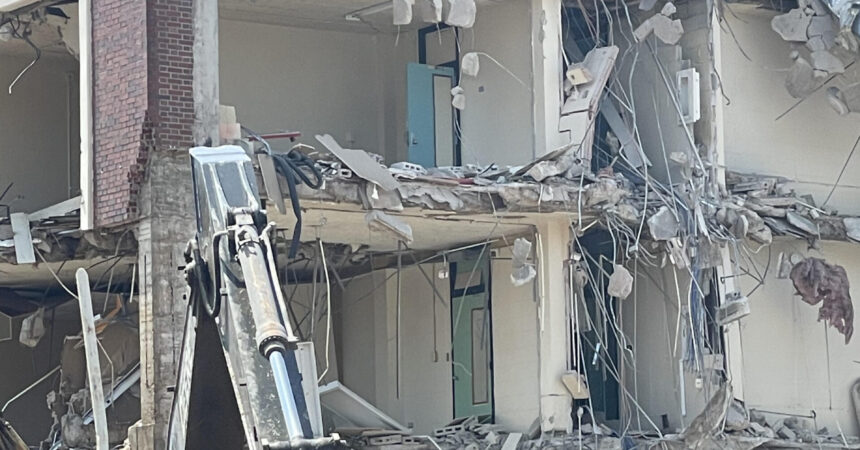
Memories are all that’s left of Gibbs Hall dorm

Photo by Stacey Rene

Photo submitted
By Stacey Rene
Special to the Outlook
A building that was once a popular gathering place for students where music was a constant is being razed from the FAMU campus.
When demolition of Gibbs Hall is completed, more than six decades of history and memories will go with it. The decision to take down the building hasn’t gone over too well with some alumni and current students. Many of them have voiced their protest on social media, claiming that the demolition strips away history.
Living in Gibbs Hall left such an indelible mark because it created a sense of community, said Roy Wood Jr., a former Gibbs Hall resident.
“It was a special place,” said Wood, who lived in the building during the late 1990’s. “We’d play spades in the lobby on a regular basis, and watch Monday Night Football. It’s where we all gathered to learn about the death of rapper Tupac Shakur and mourned. Gibbs Hall was by far the most communal of all the dorms.”
Gibbs Hall is the latest in a string of former aged dormitories that FAMU has demolished in the last four years. Truth Hall, Paddyfote were taken down before four others were added in 2019.
The university began taking down Gibbs Hall, a 300-bed unit, on Sept. 5.
Time began taking a toll on the 64-year-old building in 2019 as it began to show structural damage. One of the most devastating was a water leak that forced students in 15 rooms to relocate.
Long before the demise of Gibbs Hall started, blaring music in his dormitory was a constant for Devante Jefferson.
“The biggest memories I have there are of all the times we recorded music,” Jefferson said. “I was the only person on my floor with recording software. Every night after classes, people would be in my room making beats and recording music until six in the morning; then we’d do it all over again the next day.”
At least one attempt was made to save the building by renovating, but keeping water out was a huge and costly problem, said Jennifer Wilder, PhD., Director of University Housing.
“As we continued reviewing the building, we discovered that the structural issues were so serious that it was not safe for us to continue to have students live in the building,” she said.
Inconvenience wasn’t all that Gibbs Hall residents had to live with. According to Pure Protect, exposure to water damaged buildings could cause health issues such as respiratory diseases, heart disease and cancer. The presence of water damage can also create harmful toxic mold and even cause death in rare situations.
Those threats were beginning to become visible at Gibbs Hall, as the problem became worst over time.
“There was one early morning where I woke up and the ground was shaking as if there were an earthquake,” said Kristine Wallace, a spring 2023 graduate. “Our living conditions were a little complicated, such as the lack of heat during the cold winter.”
FAMU has spent $1.5 million for the demolition of Gibbs Hall. The price tag on Truth Hall and Paddyfote Complex was $505,000 and $915,000, respectively.
The university’s plans for the space created by removing Gibbs Hall and Paddyfoote are to construct three new residence halls to provide 2,000 beds on campus. A 500-bed dorm and parking project is planned at the Gibbs Hall and Paddyfoote sites. Additionally a 700-bed dorm is slated for the gravel parking lot just north of the Towers off Osceola Street. Another 800-bed dorm is also in the works for the former Palmetto North site.
The 700-bed residence hall is projected for completion in the fall of 2025, said Wilder, who added that the timeline for two other projects is yet to be determined.
Gibbs Hall is named in honor of the university’s co-founder Thomas V. Gibbs. It was built in 1955 and it housed 302 students at the time. Residents of the six-story building were close-knit.
“Our lobby was a central social hub,” said Ray Love Jr., a 2013 graduate. “The girls would come across campus each week to watch live airings of ‘Flavor of Love’. Our location was the spot where we’d meet up before hanging out at fraternity parties or whatever hole-in-the-wall clubs they’d let excited 18-year-olds into.
“I have vivid memories of walking the halls and hearing all sorts of music blaring from every other room – specifically Rick Ross’ “Port of Miami” that had just dropped as we were moving into dorms that August.”
Wilder said removing Gibbs Hall wasn’t an easy decision, but a necessary one.
“I want people to understand that the university did its due diligence in looking at every option before the decision was made to demolish a building,” Wilder said. “Safety and security of our students has to be our primary focus and those buildings were not safe. It was not a decision that was made lightly. We looked at renovations, but the cost did not make sense to do that.”







